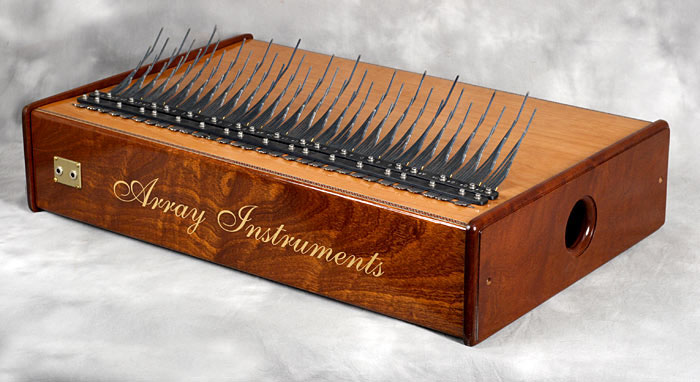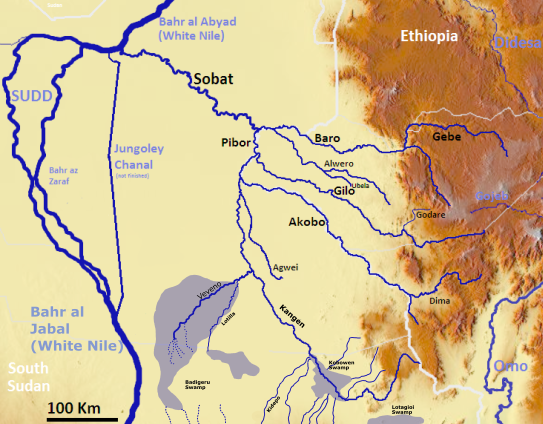|
Thoom Otieno
The tom is a plucked lamellophone thumb piano used in the traditional music of the Nuer and Anuak ethnic groups of western Ethiopia. The instruments is also called thoom Otieno and may also be spelled toom and thom. Thoom is a Anywaa word. Besides being a word for a thumb piano, the word is used generally by parts of the country’s population to mean “musical instrument.” It is also the name of an Ethiopian lyre. The state-run Ras Theatre brought music from different parts of Ethiopia to its stage, including the ‘’tom’’, played by the “Nilo-Saharan peoples from the Gambela Region.“ The instrument was also used in some pieces performed by Orchestra Ethiopia Orchestra Ethiopia was an Ethiopian concert band formed in 1963 by the Egyptian-born American composer and ethnomusicologist Halim El-Dabh. The group, which was founded in Addis Ababa, comprised up to 30 traditional instrumentalists, vocalists, an ... in the 1960s. References Ethiopian musical instrume ... [...More Info...] [...Related Items...] OR: [Wikipedia] [Google] [Baidu] |
Lamellophone
A lamellophone (also lamellaphone or linguaphone) is a member of the family of musical instruments that makes its sound by a thin vibrating plate called a lamella or tongue, which is fixed at one end and has the other end free. When the musician depresses the free end of a plate with a finger or fingernail, and then allows the finger to slip off, the released plate vibrates. An instrument may have a single tongue (such as a Jew's harp) or a series of multiple tongues (such as a mbira thumb piano). Linguaphone comes from the Latin root ''lingua'' meaning "tongue", (i.e., a long thin plate that is fixed only at one end). lamellophone comes from the Latin word ' for "small metal plate", and the Greek language, Greek word ''phonē'' for "sound, voice". The lamellophones constitute category 12 in the Hornbostel–Sachs system for classifying musical instruments, plucked idiophones. There are two main categories of plucked idiophones, those that are in the form of a frame (121) and t ... [...More Info...] [...Related Items...] OR: [Wikipedia] [Google] [Baidu] |
Thumb Piano
Mbira ( ; ) are a family of musical instruments, traditional to the Shona people of Zimbabwe. They consist of a wooden board (often fitted with a resonator) with attached staggered metal tines, played by holding the instrument in the hands and plucking the tines with the thumbs (at minimum), the right forefinger (most mbira), and sometimes the left forefinger. Musicologists classify it as a lamellaphone, part of the plucked idiophone family of musical instruments. In Eastern and Southern Africa, there are many kinds of mbira, often accompanied by the hosho, a percussion instrument. It is often an important instrument played at religious ceremonies, weddings, and other social gatherings. The "Art of crafting and playing Mbira/Sansi, the finger-plucking traditional musical instrument in Malawi and Zimbabwe" was added to the UNESCO Representative List of the Intangible Cultural Heritage of Humanity in 2020. A Western interpretation of the instrument, the kalimba, was commercia ... [...More Info...] [...Related Items...] OR: [Wikipedia] [Google] [Baidu] |
Nuer People
The Nuer people are a Nilotic peoples, Nilotic ethnic group concentrated in the Greater Upper Nile region of South Sudan. They also live in the Ethiopian region of Gambela Region, Gambella. The Nuer speak the Nuer language, which belongs to the Nilotic languages, Nilotic language family. They are the second-largest ethnic group in South Sudan and the largest ethnic group in Gambella, Ethiopia. The Nuer people are pastoralists who herd cattle for a living. Their cattle serve as companions and define their lifestyle. The Nuer call themselves "Naath". Overview The Nuer people have historically been undercounted because of the semi-nomadic lifestyle. They also have a culture of counting only older members of the family. For example, the Nuer believe that counting the number of cattle one has could result in misfortune and prefer to report fewer children than they have. Their South Sudan counterparts are the Horn peninsula's westernmost Horners. History The Nuer people are said t ... [...More Info...] [...Related Items...] OR: [Wikipedia] [Google] [Baidu] |
Anuak People
The Anyuak, also known as Anyuaa and Anywaa, are a Luo Nilotic ethnic group inhabiting parts of East Africa. The Anuak belong to the larger Luo family group. Their language is referred to as Dha-Anywaa. They primarily reside in the Gambela Region of western Ethiopia, and South Sudan. Group members number between 200,000 and 300,000 people worldwide. Many of the Anyuak people now follow Christianity. It is one of the first of the Nilotic groups to become almost entirely Christian, following the Shilluk people. History According to American non-profit organization Cultural Survival, the Anuak originally lived on land near the Pibor River and the Sobat River, in present-day eastern South Sudan near Ethiopia. Due to displacement from other groups, most Anuak now live along the Baro River and the Akobo River. The Anuak are a Nilotic people. They have lived in the area of the Upper Nile for hundreds of years and consider their land to be their tribal land. Unlike other Nilo ... [...More Info...] [...Related Items...] OR: [Wikipedia] [Google] [Baidu] |
Ethiopia
Ethiopia, officially the Federal Democratic Republic of Ethiopia, is a landlocked country located in the Horn of Africa region of East Africa. It shares borders with Eritrea to the north, Djibouti to the northeast, Somalia to the east, Kenya to the south, South Sudan to the west, and Sudan to the northwest. Ethiopia covers a land area of . , it has around 128 million inhabitants, making it the List of countries and dependencies by population, thirteenth-most populous country in the world, the List of African countries by population, second-most populous in Africa after Nigeria, and the most populous landlocked country on Earth. The national capital and largest city, Addis Ababa, lies several kilometres west of the East African Rift that splits the country into the African Plate, African and Somali Plate, Somali tectonic plates. Early modern human, Anatomically modern humans emerged from modern-day Ethiopia and set out for the Near East and elsewhere in the Middle Paleolithi ... [...More Info...] [...Related Items...] OR: [Wikipedia] [Google] [Baidu] |
Anywaa
The Anyuak, also known as Anyuaa and Anywaa, are a Luo Nilotic ethnic group inhabiting parts of East Africa. The Anuak belong to the larger Luo family group. Their language is referred to as Dha-Anywaa. They primarily reside in the Gambela Region of western Ethiopia, and South Sudan. Group members number between 200,000 and 300,000 people worldwide. Many of the Anyuak people now follow Christianity. It is one of the first of the Nilotic groups to become almost entirely Christian, following the Shilluk people. History According to American non-profit organization Cultural Survival, the Anuak originally lived on land near the Pibor River and the Sobat River, in present-day eastern South Sudan near Ethiopia. Due to displacement from other groups, most Anuak now live along the Baro River and the Akobo River. The Anuak are a Nilotic people. They have lived in the area of the Upper Nile for hundreds of years and consider their land to be their tribal land. Unlike other Nilotic p ... [...More Info...] [...Related Items...] OR: [Wikipedia] [Google] [Baidu] |
Nilo-Saharan Languages
The Nilo-Saharan languages are a proposed family of around 210 African languages spoken by somewhere around 70 million speakers, mainly in the upper parts of the Chari River, Chari and Nile rivers, including historic Nubia, north of where the two tributaries of the Nile meet. The languages extend through 17 nations in the northern half of Africa: from Algeria to Benin in the west; from Libya to the Democratic Republic of the Congo in the centre; and from Egypt to Tanzania in the east. As indicated by its hyphenated name, Nilo-Saharan is a family of the African interior, including the greater Nile Basin and the Central Sahara Desert. Eight of its proposed constituent divisions (excluding Kunama languages, Kunama, Kuliak, and Songhai languages, Songhay) are found in the modern countries of Sudan and South Sudan, through which the Nile River flows. In his book ''The Languages of Africa'' (1963), Joseph Greenberg named the group and argued it was a genetic (linguistics), genetic fam ... [...More Info...] [...Related Items...] OR: [Wikipedia] [Google] [Baidu] |
Gambela Region
The Gambela Region, also spelled Gambella, and officially the Gambela Peoples' Region (), is a regional state in western Ethiopia. Previously known as Region 12, its capital and largest city is Gambela. It is bordered by the Oromia Region to the east, the South West Ethiopia Region to the south, and the country of South Sudan to the west. Gambela is situated between the Baro and Akobo Rivers, with its western part including the Openo River. It covers an area of approximately 29,783 square kilometers with a population of 525,000 inhabitants, making it one of Ethiopia's smallest regions and one of its least populous. Gambela is home to a diverse population which includes the Anuak, Nuer, and other indigenous groups collectively referred to as the Majang Komo and Opo. History This region served as slave-hunting grounds by Christian Abyssinians for centuries, and the Nilosaharan-speaking inhabitants were pejoratively called Shanqella (Šanqəlla, also Shanqila, Shankella) ... [...More Info...] [...Related Items...] OR: [Wikipedia] [Google] [Baidu] |
Orchestra Ethiopia
Orchestra Ethiopia was an Ethiopian concert band formed in 1963 by the Egyptian-born American composer and ethnomusicologist Halim El-Dabh. The group, which was founded in Addis Ababa, comprised up to 30 traditional instrumentalists, vocalists, and dancers from many different Ethiopian regions and ethnic groups (including Amhara, Tigrayans, Oromo, Welayta, and Gimira). It was the first ensemble of its type, as these diverse instruments and ethnic groups previously had never played together. For a time, due to El-Dabh's efforts, the Orchestra was in residence at the Creative Arts Centre of Haile Selassie I University (now Addis Ababa University). Overview Its main instruments included ''krar'' (medium lyre), '' masenqo'' (one-string fiddle), '' begena'' (large lyre), ''washint'' (end-blown flute with finger holes), '' embilta'' (end-blown flute without finger holes), '' malakat'' (straight trumpet), '' kabaro'' (drum), and other percussion instruments. On occasion, it also used ... [...More Info...] [...Related Items...] OR: [Wikipedia] [Google] [Baidu] |
Ethiopian Musical Instruments
Ethiopian music is a term that can mean any music of Ethiopian origin, however, often it is applied to a genre, a distinct modal system that is pentatonic, with characteristically long intervals between some notes. The music of the Ethiopian Highlands uses a fundamental modal system called '' qenet'', of which there are four main modes: , , , and . Three additional modes are variations on the above: tezeta minor, bati major, and bati minor. Abatte Barihun, liner notes of the album Ras Deshen, 200. Some songs take the name of their qenet, such as tizita, a song of reminiscence. When played on traditional instruments, these modes are generally not tempered (that is, the pitches may deviate slightly from the Western-tempered tuning system), but when played on Western instruments such as pianos and guitars, they are played using the Western-tempered tuning system. Music in the Ethiopian highlands is generally monophonic or heterophonic. In certain southern areas, some music is po ... [...More Info...] [...Related Items...] OR: [Wikipedia] [Google] [Baidu] |




